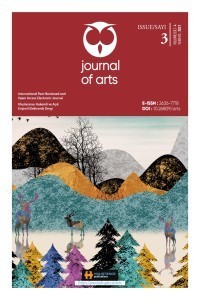TEKNOLOJİ VE SANAT
Geçmişten bu yana, sanat dallarında bir ürün ortaya koyabilmek, söz konusu alana ait araç ve gereçleri kullanmaya yönelik belli bir tekniğin icrası ile mümkün olabilmiştir. Bu nedenle tekniğin bilimsel düzlemde ele alınması ve geliştirilmesini hedefleyen “teknoloji” sanatsal üretime ait koşulların bir parçasıdır. Bununla beraber sanat alanındaki teknik yenilikler salt sanat dalının özgül araç ve gereçlerinden kaynaklanmayıp çağın diğer teknolojik gelişmelerinden de payını almıştır. Özellikle Rönesans’tan itibaren pek çok “yardımcı teknoloji” sanatçılar tarafından kullanılmıştır. İzdüşümü ve perspektif makinaları, “camera obcura”, “camera lucida”, sanatsal ve endüstriyel çoğaltım teknikleri, fotoğraf, sinema, televizyon, fax, fotokopi, bilgisayar, üç boyutlu şekillendiriciler ve kitlesel iletişim teknolojileri günümüze doğru ilerleyen süreçte sanata hem estetik kavramlar açısından hem de üretim ortamına getirdiği yenilikler ile etkide bulunmuştur. Ancak, teknolojik gelişmelerin sanatsal açıdan yorumlanması ve bir anlamda dönüştürülmesi, sanatın estetik, teknik ve kavramsal boyutları açısından önem taşıyan bir sorunsalı olmaya devam etmektedir
TECHNOLOGY AND ART
Ceramic material has continuously been a part of the culture as from the time For thousands of years, producing a product in the fields of art has been made possible by performing a specific technique towards using the instruments belonging to the mentioned field. For this reason, dealing with and developing technique on a scientific level, that is to say, “technology” is a part of the conditions belonging to artistic production. Along with this, these technical innovations did not only result from the specific instruments of the field of art but also took its share from the other technological developments of the era. Particularly since Renaissance, several “auxiliary technologies” have been used by the artists that have made productions in the fields of arts. Projection and perspective machines, “camera obscura”, “camera lucida”, artistic and industrial duplication techniques, photographs, cinema, television, fax, photocopy, computer, three-dimensional modeling and developing mass media have had an impact on art during the process moving forward to the present day in terms of both aesthetical concepts and innovations they have brought to the production medium. Along with this, artistic interpretation, in a sense, transformation of technological phenomena continues to be an important problem in terms of the aesthetic, technical and conceptual dimensions of art.
Keywords:
Art, Technic, Technology, Aesthetic, Originality.,
- ISSN: 2636-7718
- Başlangıç: 2018
- Yayıncı: Holistence Publications
